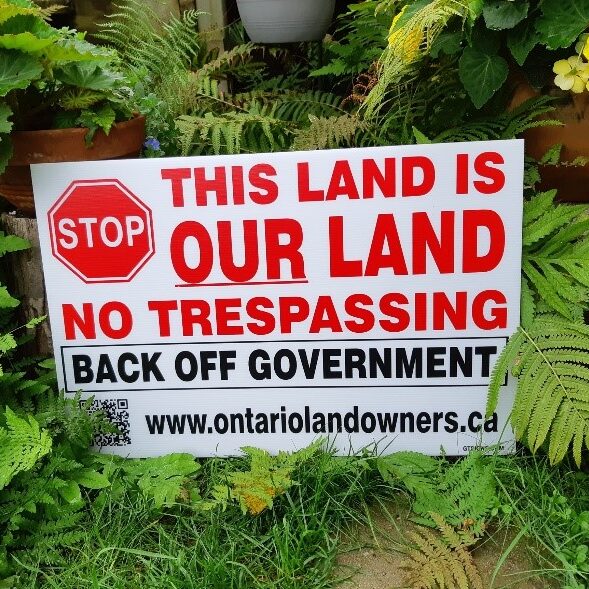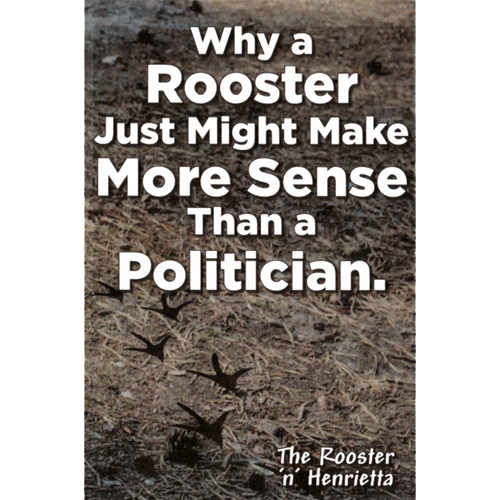The internationally based plan behind Natural Heritage Plans by John Schwartzentruber
- 2019-08-01
- By admin
- Posted in Latest News
The room grew silent, rather like the air had just been sucked out of it. It was a very uncharacteristic type of quiet for a bunch of farmers who had been quite vocal about every other issue tackled at a recent, day-long CFFO policy meeting.
The sudden chill resulted from hearing an information package which documented and exposed the Plan behind the Natural Heritage Plans that are making themselves felt across many counties in Ontario. Because few others present at this policy-discussion meeting were aware of the origin of Natural Heritage Plans. The facts, presented directly from United Nations documents, stunningly contradicted the foundational values that the listeners embraced as part of their Canadian heritage.
The Plan behind the Natural Heritage Plans? The Plan is to bring under public control all our lands – farms, country properties, lakefront holdings, all of it. Private property will no longer be private property; it’s there for the good of “all” and controlled by “all”. Collectivization unbridled.
Not so fast, you might be thinking. “You’re talking rubbish!” How and when did this Plan start? If the query sounds familiar, it is. Because a closely related question was raised in another piece recently published in this paper – “Landowners repeatedly asked ‘who is driving this?’” (Beware the E.P. designation, Atkinson, June 25/19) The trail becomes clear and irrefutable after a review of several key U.N. documents where a few sample sentences provide the answer.
The Plan can be traced to its early roots at a United Nations conference now known as U.N.
Habitat 1, held in Vancouver, B.C, 1976. The conference was called “…to address the extremely serious condition of human settlements…”, a highly altruistic-sounding goal. (Did anyone question if the conditions in Canada, with its enviable living standard, were really that serious?)
A couple of key lines from U.N. Habitat 1 laid the groundwork for the elimination of private property rights in Canada and nations similarly governed. To the point, under “Section 10 – Land” it states: “Land, because of its unique nature and the crucial role it plays in human settlements, cannot be treated as an ordinary asset, controlled by individuals and subject to the pressures and inefficiencies of the market…”
After listing a few perceived faults of private property control such as “social injustice”, the “solution” is this: “Public control of land is therefore indispensable to its protection as an asset and the achievement of long-term objectives…policies and strategies.” Public control, not private!
If that’s not raising enough red flags, a few more might be flapped with further reading which outlines the need for governments to have detailed knowledge of the “assets”, mapping all resources, necessarily curtailing individual rights, and then going on to declare that social justice goals can be met by taxing any new developments or “changes of use”, the proceeds of which would be redistributed to the community. Developments which, of course, would only be permitted by the good graces of a government that presumes to be wiser than the private investor. Ontario Farmer Article July 17, 2019
“Above all”, it goes on to say, “Governments must have the political will to evolve and implement innovative and adequate urban and rural land policies…”
Not clear enough yet? Well then a few lines later, in all capital letters we read: “LAND IS A SCARCE RESOURCE WHOSE MANAGEMENT SHOULD BE SUBJECT TO PUBLIC SURVEILLANCE AND CONTROL IN THE INTEREST OF THE NATION.”
If these few tidbits of U.N. land-grabbing imperatives are not yet enough to send a chilly crawl up the nape of one’s capitalist neck, the next few pages of U.N. Habitat 1 detail how “… such control may be exercised”. And here is where we may find ourselves on more familiar ground as we read terms like “zoning and land-use planning, compulsory registration, land use changes, legal controls, building and local permits” – all well-known language that appears in your local municipal policy and planning books. To those mayors who thought they were the head of council – are your knees a bit rubbery?
At the risk of being labeled the bringer of bad news, the bitter quill is not yet drained: The U.N. exhorts us in specific ways on how to redistribute “unearned” profit or gain through taxation. Receiving special mention is what we know in common jargon as “capital gains tax”. If this sampling of U.N. Habitat 1 diet has not satisfied your curiosity of where Natural Heritage Plans came from, it can easily be read in its entirety online: one can read to their heart’s discontent. But what will be discovered in those pages are two basic goals: the public ownership of land, and the public control of “private” land.
And the implement for achieving many of these objectives is your local Planning Department as is specifically reinforced in U.N. Habitat ll, held in Istanbul, Turkey, 1996. The goals laid out in the Habitat papers are then fleshed out in greater detail in “U.N. Agenda 21” and “2030: Agenda for Sustainable Development”. More happy bedtime reading for you as you watch the summer sun sink in the West.
One thing that becomes clear is that almost none of the planners, policy and decision makers consulted are aware of the origins of Natural Heritage Plans. There is seemingly a dearth of understanding that the United Nations is remotely insinuating their policies on the local level through the Holy Grail of the “Official Plan”, at the behest of the Provincial Policy Statement, which in turn has its strings pulled by globalist designs.
It’s notable that the critics of the Natural Heritage Plan are routinely and summarily dismissed as presenting “misinformation”. Is withholding information not a form of misinformation? How does anyone dismiss the origin of Natural Heritage Plans with the documentation provided? And why do the proponents of Natural Heritage Plans dismiss both documented and abundant anecdotal evidence presented which demonstrates that Natural Heritage Plans do indeed interfere with agriculture in both subtle and obvious ways? It’s almost as if that was the purpose of the Plans?
However the logic for Heritage Plans may be presented, collectivist ideology is unabashedly the driver behind the globalization of our domestic landscape – environmentally, culturally, financially. Once they are fully implemented, will our traditional structures and heritage that has provided so many benefits to us even be recognizable?
Do the Natural Heritage Plans that are being imposed across Ontario have less to do with protecting the environment, and everything to do with taking public control of land? Ontario Farmer Article July 17, 2019
Are there those who mistakenly remember the Feudal system as an example of raging success – which poverties and rampant mortality rates our ancestors fled for a better land? This road inevitably leads back there.
Why did the Marxist Soviet Union collapse if central planning and control were the hallmark of growth and equality? Tiananmen Square? Venezuelan-style dictatorship, anyone?
News reports indicate that there is a rising will among Ontario’s private land and property owners in rejecting the shiny front put on Heritage Plans by planning departments. Special mention goes to the good folks of Norfolk County – now there’s a stalwart bunch – who reportedly stepped up to the task and respectfully made their objections known to their County Council. It made a difference.
When all the U.N. goals and their effects are linked together, the one rational conclusion is that Natural Heritage Plans are a dismantling of the foundational governance and sovereignty of Canada, an all-out attack on our true heritage. Just as planned.
This article by John Schwartzentruber, Huron County, was originally published in the Ontario Farmer in its July 16, 2019 edition.
Search:
Categories
Archives
- April 2024
- January 2024
- December 2023
- November 2023
- August 2023
- July 2023
- June 2023
- May 2023
- April 2023
- March 2023
- February 2023
- January 2023
- December 2022
- November 2022
- October 2022
- September 2022
- August 2022
- July 2022
- June 2022
- May 2022
- April 2022
- March 2022
- February 2022
- January 2022
- December 2021
- November 2021
- October 2021
- September 2021
- August 2021
- July 2021
- June 2021
- May 2021
- April 2021
- March 2021
- February 2021
- January 2021
- December 2020
- November 2020
- October 2020
- September 2020
- August 2020
- July 2020
- June 2020
- May 2020
- April 2020
- March 2020
- February 2020
- January 2020
- December 2019
- November 2019
- October 2019
- September 2019
- August 2019
- July 2019
- June 2019
- May 2019
- April 2019
- March 2019
- February 2019
- January 2019
- December 2018
- November 2018
- October 2018
- September 2018
- August 2018
- July 2018
- June 2018
- May 2018
- April 2018
- March 2018
- February 2018
- January 2018
- December 2017
- November 2017
- October 2017
- September 2017
- August 2017
- July 2017
- June 2017
- May 2017
- April 2017
- March 2017
- February 2017
- January 2017
- December 2016
- November 2016
- October 2016
- September 2016
- August 2016
- July 2016
- June 2016
- May 2016
- April 2016
- March 2016
- February 2016
- January 2016
- December 2015
- November 2015
- October 2015
- September 2015
- August 2015
- July 2015
- June 2015
- May 2015
- April 2015
- March 2015
- February 2015
- January 2015
- December 2014
- November 2014
- October 2014
- September 2014
- August 2014
- July 2014
- June 2014
- May 2014
- April 2014
- March 2014
- February 2014
- January 2014
- December 2013
- November 2013
- October 2013
- September 2013
- August 2013
- June 2013
- April 2013
- October 2012
- May 2012
- September 2011



